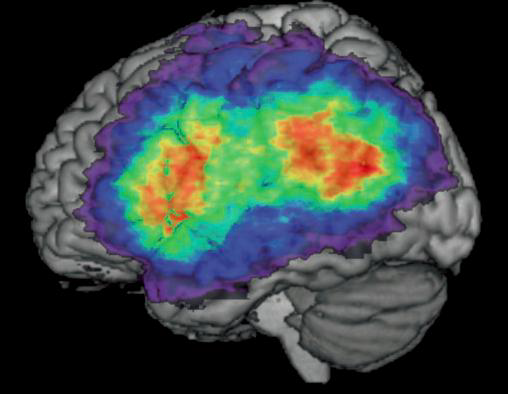
How our brains work is one of the big questions still confronting neuroscientsts today. Although it is now widely accepted that different regions of the brain perform different functions, such as speaking or gesturing, exactly what those functions are and how they interact remains a matter of debate. For over a century, scientists and clinicians have relied on the insights provided by studying patients with brain damage or degeneration to answer this question. Individuals with strokes, for example, often have relatively focal damage in an otherwise healthy brain. As a result, these patients typically have a specific set of behavioral impairments that varies from patient to patient. Studying the individual impairments of a given patient thus allows researchers to identify connections between specific brain areas and the behaviors they govern, and it also allows clinicians to better understand the underlying causes of the behavioral disorders they are treating.
One drawback to studying patients on a case-by-case basis is that the brain areas that are disrupted following a stroke do not necessarily follow the outlines of the brain areas guiding specific behaviors. Thus, a single stroke, for example, may partially disrupt several different functional brain regions at the same time. To get a better sense of how brain and behavior are related, researchers can use a technique called Lesion-Symptom Mapping. This method identifies common behavioral and brain relationships across a large number of patients, allowing researchers to isolate the specific region that is responsible for a particular behavior, and it is used frequently by a few researchers at MRRI. This past January, MRRI scientist Aaron Wong, PhD organized a three-session workshop led by Research Assistants Harrison Stoll and Austin Wild and Postdoctoral Fellow Frank Garcea, PhD. Workshop participants at MRRI and internationally attended with the goal of learning about recent developments in this method in order to increase understanding and awareness of how to properly utilize this powerful technique.
As with all research methods, Lesion-Symptom Mapping approaches are continually being developed and refined. Over the past 6 years, this method has made rapid advances as more powerful computers and new statistical techniques such as machine learning have become available. However, those leaps forward have occurred at such a rapid pace that many researchers still do not fully understand how these new techniques work, when they should be applied, and what are their limitations. In this workshop, our goal was to explain in detail the entire process involved, starting from acquiring a brain scan of a patient to map out the extent of their brain damage, all the way to proper interpretation of the method’s results. Our workshop speakers, all experts at different portions of this analysis method, provided insights about the how and why of the various stages involved, and they pointed out common pitfalls and important points to consider along the way. In the spirit of open science and increased transparency, we have made all of the talks, example data sets, and code from the workshop publicly available on our website. We did this in the hope that more researchers would use this technique, but also to encourage researchers to be more thoughtful about its use and applications.
When applied correctly, Lesion-Symptom Mapping allows researchers to identify the specific regions of the brain that are critical for performing behaviors and to map out exactly what processes are and are not disrupted in each patient. Such knowledge can inform clinicians about which rehabilitation techniques may be most useful to try, either by specifying the specific deficit that needs to be retrained or by identifying which compensatory processes may be spared and can be leveraged to recover analogous behaviors. Thus, Lesion-Symptom Mapping is an important tool for both understanding the brain and laying the foundation for the development of targeted and personalized neurorehabilitation efforts.
To learn more about the LSM Workshop and watch the recordings, click here.
For more information on Dr. Wong’s research, click here.


3 comment on “MRRI Hosts Lesion-Symptom Mapping Workshop”